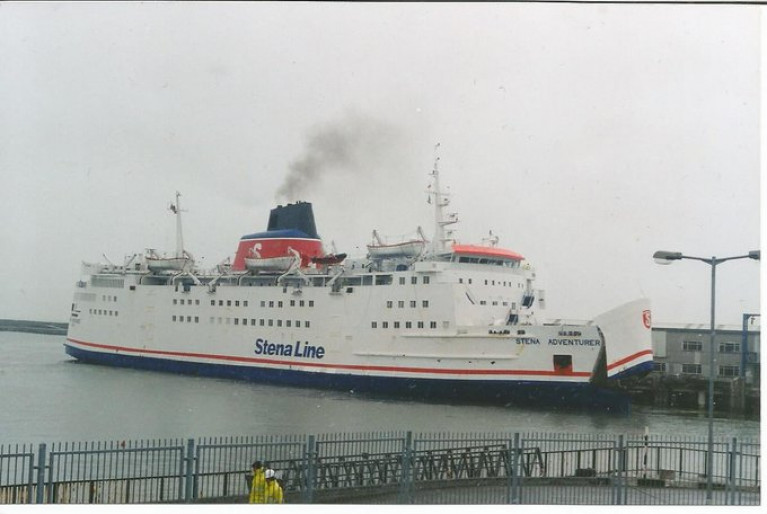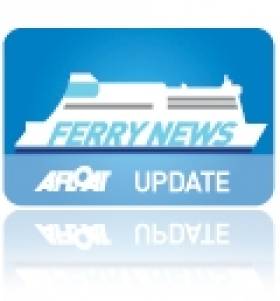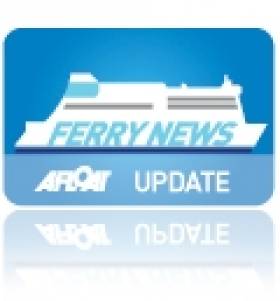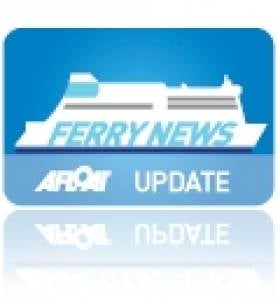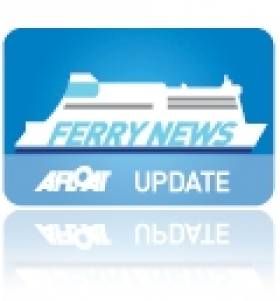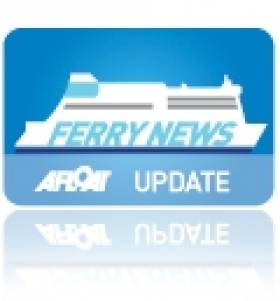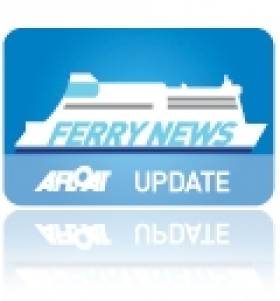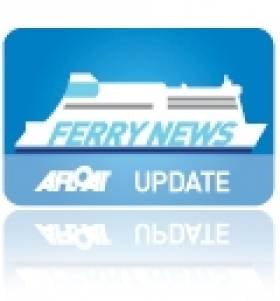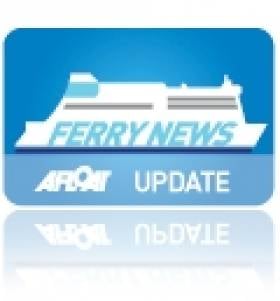Displaying items by tag: Dun LaoghaireHolyhead
St. Columba: Dun Laoghaire-Holyhead's Final Conventional Car-Ferry Scrapped in South Asia
St. Columba, British Rail/Sealink's largest custom-built Dun Laoghaire-Holyhead ferry which served many a generation with fond memories and which left the Irish Sea 25 years ago, has gone for scrapping in Pakistan, writes Jehan Ashmore.
The 44 year-old Massarah, originally of 7,836grt when launched as St. Columba in 1977 at the Aalborg Werft A/S in Denmark to serve the premier Ireland-Wales route, replaced a pair of classic 'mail-boats' Hibernia and Cambria. In addition the £19m ferry displaced Holyhead Ferry I, built in 1965 for the route albeit this smaller car ferry was only stern-loading. St. Columba with 2,400 passengers was the biggest on the Irish Sea and carried 335 cars or 36 lorries or a combination of both.
In December, Afloat referred (see photo-caption) that St. Columba /Massarah had gone to the shipbreakers as the renamed Assarah when beached at Gadani, famously known for shipbreaking. The ferry after its Irish Sea career went to the Mediterranean where in Greek waters served as Express Aphrodite until 2006.
This was followed with a career serving Egyptian based shipowners, Namma Shipping Lines trading in the Red Sea with calls to include Jeddah in Saudi Arabia. This involved Massarah serving the busy annual Islamic pilgrimage when Muslims headed to Mecca where the Haji is held.
For almost 20 years, St. Columba plied the 57 nautical-mile Irish Sea route and after Sealink UK was privatised by the UK Government in 1984, was acquired by Sea Containers and with the altered brand name of Sealink British Ferries. The ship retained its Sealink name, see photo.
This was followed in 1990 by another owner, Stena Line which led to the ship renamed twice. In the following year a major internal refit led to the first renaming as Stena Hibernia, this in hommage to the route's historical mail-boat heritage by the Swedish shipowner.
But in the final years on the Irish Sea, the ferry took on another name, Stena Adventurer until withdrawn from the Irish Sea route in 1996.
In that same year was introduced the Highspeed Sea Service (HSS) Stena Explorer, a craft that marked a significant new era on the link as then the world's largest and fastest vehicle carrying/passenger fast-ferry. The 1,500 passenger craft also handled 375 cars and 50 lorries.
To the ferry purest in particular, the contrast was considerable marked, as the almost 20 knot St. Columba offered a two-class service spread across two main passenger decks. They included lounge/bars named Landsdowne and Cardiff Arms in recongition of rugby travellers! In addition to waiter and self-service buffet restaurents, TV lounges, discoteque, a duty-free shop and nursing mother's room. However, by 1983 the 129m ferry was altered to a single-class passenger service.
Compared to St. Columba, the HSS Stena Explorer (preceded by a trio smaller 'Lynx' fast craft) consisted of just a single football sized passenger deck with open plan seating offering panoramic views through giant lattice windows. Though, despite the craft's much shorter 99-minute link been an advantage, the HSS still offered a Stena Plus / Motorists lounge, located forward and was impressive when underway at 40 knots! In addition to lounges, Duty-Free, MacDonalds and large-screen video panels for information etc.
Yet, despite the revolutionary design of the futuristic craft, the HSS only had a career of just 18 years on the Irish Sea when ceasing in 2014. (See: Ships Monthly, June 2015 for 'Farewell to Stena HSS' feature).
Whereas, St. Columba etc, had served for almost two decades, except for a single yet brief exception in 1982, having strayed to the St. Georges Channel. This was to stand in for chartered-in Stena Normandica while out of service on Sealink's Rosslare-Fishguard route.
St. Columba was named after the 6th century Irish abbot and with the ferry following sea trials was delivered in 1977 as alluded. Receptions were held in the ferry's homeport of Holyhead and then in Dun Laoghaire following an inaugural sailing from Anglesey in April. On board were members of the British Rail Board, tourism and other diginaties and at the Irish port the Taoiseach (prime minister) Liam Cosgrave was invited on board and also a reception was held in the nearby Royal Marine Hotel.
A maiden commercial crossing took place later from Holyhead to Dun Laoghaire, a route with origins that can be traced to 1835.
Introduction of St. Columba proved to be an instant success having after just one year in service carried its 1 millionth passenger. As the multi-purpose single ship modernised the link and notably as the Irish Sea's largest ferry with passengers accommodated in 1st and 2nd class quarters.
However, for many generations of Irish people emigrating to Britain and beyond, St. Columba, albeit sadly played a part in the nation's diapora. As the next step for passengers having disembarked in north Wales, was taking onward bus or train connection to UK cities and London to seek work.
Passenger traffic albeit of a happier note saw holidaymakers between the nations and those beyond taking the UK 'landbridge' to / from continental Europe. To those exclusively seeking a bargain with duty-free shopping (see recent comeback) or for some just intending a round-trip excursion.
St. Columba on a personal basis provided childhood memories having observed off the Kish Bank lighthouse, Dublin Bay and within Dun Laoghaire Harbour. In addition to having embarked on family holidays in 1981 and the following year, by taking the aforementioned 'landbridge' routes to France.
Noting some of these English Channel ferries would also serve on the Irish Sea due to a variety of operational reasons. The presence of Sealink's French-flagged counterpart ferries in Dun Laoghaire Harbour then seemed exotic! This was an added bonus and would strenghten my childhood interest with ferries and shipping in general.
When watching the St. Columba arrive in Dun Laoghaire, the somewhat stout-looking ship, when observed looking at certain angles, would berth bow-on at the harbour's linkspan at Carlisle Pier. It was at the adjacent quayside where the 'mail-boat' would occupy and opposite of the East Pier's Victorian bandstand.
This was an advantagous spot for onlookers when St. Columba's stern swung around (see recent Anna G containership story) for departures prior to heading through the harbour mouth.
Also fascinating to see was when the bow-visor opened when approaching the pierside, whereas in Holyhead, operations involved the stern-door when berthing in the port's inner harbour.
The confined harbour in Anglesey was why the ferry was designed with a stern-bridge to enable easier navigation when going astern beyond the Salt Island before swinging around within the harbour to head off the breakwater. See, recent Storm Barra / public access closure story.
Afloat understands that a former fleetmate of Stena Hibernia, the Altair, formerly St. Anselm/ Stena Cambria which served in tandem on the Irish Sea route during the early 90's, was awaiting to be broken up also in Asia.
As according to AIS, last month the ferry was last indicated to be offshore off Chittagong in Bangladesh.
New Ferry Operator for Dun Laoghaire Harbour Remains to Be Seen in 2016?
#FerryService2016? – A new ferry operator sought for the Dun Laoghaire-Holyhead route this year remains to be seen following Stena Line's closure of the service in 2014 and with only months away before the summer season begins, writes Jehan Ashmore.
Stena finally confirmed in early 2015 to permanently close the historic route dating to 1835, by consolidating existing operations in neighbouring Dublin Port where since 1995 the company have also run a service to Holyhead.
Responding to Afloat.ie, a spokesperson for Dun Laoghaire Harbour Company said at this moment they could not make any further comment on a ferry service in 2016, but they added they hoped to be in a position to make a comment sometime early this year.
It is almost a year ago when DLHC received seven expressions of interest from operators to provide a seasonal-only ferry service to Holyhead following an e-Tender advert.
Commenting then on the expressions of interest recieved, DLHC and said they 'will now consider these' and added 'final configurations would be a matter for discussion and agreement with a new provider, and would be in keeping and take account of the Harbour Company's Masterplan'.
According to a document from the advert, a berth is available which is 140 metres long and with a maximum depth of 5.8 metres. In addition the berthing facility is described as having a shore to ship ramp, which can easily be modified to facilitate the configuration of a new vessel.
Afloat.ie adds that St. Michaels Pier has two berths, one is custom-built to only accommodate the specialist requirements of the HSS Stena Explorer when the highspeed fast-craft was withdrawn from service in September 2014. There are plans to remove this berth which requires planning permission for its dismantling.
The second conventional berth on St. Michaels Pier was also used by Stena Line when a smaller 'Lynx' fast-ferry craft, Stena Lynx III had also operated the Ireland-Wales route in recent years.
The Stena Lynx III had served shoulder seasons when HSS Stena Explorer reduced operating its full year-round service until 2011. It was in that same year the ‘Lynx’ was sold to overseas owners in Asia.
#FerryDunLaogaire? – Dun Laoghaire Harbour Company has received seven expressions of interest from operators to provide a seasonal-only ferry service to Holyhead, writes Jehan Ashmore.
Afloat.ie has contacted the DLHC following last Friday's advert deadline for potential ferry operators to operate on the 52 nautical mile route.
A month ago, Stena Line confirmed the permanent closure of the historic Ireland-Wales link.
Prior to the ferry company responses, DLHC annnounced that any new operator would not be serving the route until at least 2016.
Following the responses, a spokesperson on behalf of DLHC said they 'will now consider these'. The harbour company added, 'final configurations would be a matter for discussion and agreement with a new provider, and would be in keeping and take account of the Harbour Company's Masterplan'.
As part of the Masterplan, the site of St. Micheal's Pier is where a major residential redevelopment is proposed.
For more than 170 years there has been a ferry service running between Dun Laoghaire and Holyhead from where Stena Line has served the Irish Sea service since 1990.
In additon to conventional ferry tonnage, they introduced a small 'Lynx' fast-ferry in 1993 which was replaced by the world's largest fast craft, the HSS Stena Explorer in 1996.
Stena's decision to withdraw operations in the south Dublin Bay port, leaves a berth available for a new ferry operator in Dun Laoghaire Harbour using the terminal at St. Michaels Pier.
According to the advert document the berth is 140 metres long with a maximum depth of 5.8 metres. In addition the berthing facility is described as having a shore to ship ramp, which can easily be modified to facilitate the configuration of a new vessel.
Afloat.ie adds that St. Michaels Pier has two berths, one is custom-built to only accommodate the specialist requirements of the HSS Stena Explorer.
The second adjacent berth was also used by Stena Line when a 'Lynx' craft as previously referred but had returned in more recent years to the route. The Stena Lynx III served during the shoulder seasons when the HSS Stena Explorer had operated a year-round service until 2011.
The 19,638 tons HSS remains at her homeport of Holyhead and likewise at a custom-built berth in the inner harbour of the Welsh port.
Also in Anglesey is the Stena Superfast X, which made a delivery voyage last week from Poland having had a major refit. The 30,551 tons newcomer has yet to enter service on the Holyhead-Dublin Port route in competition with Irish Ferries.
Stena's Larger Ship for Dublin Port Route Raises Uncertainty over Future of Dun Laoghaire-Holyhead Service?
#StenaHSSfuture? – Stena Line's introduction of Stena Superfast X to expand capacity on the Dublin-Holyhead route in early 2015, raises uncertainty over the future of the Dun Laoghaire HSS operated service to Wales, writes Jehan Ashmore.
Now that Superfast X a larger passenger and freight ship of 29,500 tonnes is to make a debut in early 2015, this week's announcement comes at a time when speculation continues to mount over the re-opening in 2015 of the Dun Laoghaire-Holyhead route. In addition it raises the issue of whether the High Speed Sea-Service (HSS) Stena Explorer will return or by a smaller fast-ferry?
The route's main summer-season service ceased in September and the recent news to cancel Christmas sailings marked the first time the HSS operated route has been closed over the festive and early New Year.
Afloat.ie asked Stena to comment on the introduction of increased capacity by Superfast X on the Dublin Port route and the future viability of the Dun Laoghaire route served by the High Speed Sea-Service (HSS) Stena Explorer currently tied-up in Holyhead.
Once again the reply was a familiar response, "Stena Line is currently engaged in on-going discussions with Dun Laoghaire Harbour in relation to the provision of a seasonal fast craft service in 2015".
When Stena Superfast makes her debut in early 2015 on the core Dublin-Holyhead central corridor route, she will bring increased capacity for 1,200 passengers, notably compared to around 400 as carried by the vessel she is to directly replace, Stena Nordica.
In addition the newcomer most recently serving Dover-Calais service, is currently undergoing vehicle deck conversion work by MacGregor, the contractor which will also increase capacity to almost 2kms of lane space for cars and freight.
Plus the 'Superfast X' is having a refit to upgrade of passenger facilities in readiness for when she enters on the Dublin route. She will join the existing service's second ship, Stena Adventurer which is more of an even match compared to the 'Nordica'.
Stena Line clearly are confident in the route's potential as Dublin Port is a key strategic tourism gateway and on foot of a recovering economy. The operator citing leisure and commercial traffic between Ireland and Britain are showing really encouraging signs of future growth.
Already in service since 2011 are her sisters Superfast VII and VIII which operate on the Belfast-Cairnryan route.
As for the fuel thirsty and expensive to operate HSS Stena Explorer, the catamaran fast-ferry stood down from the Dun Laoghaire-Holyhead having operated the summer-seasonal service that began in April and ran through to early September.
This year was the HSS crafts third consecutive season of only operating a summer-only service since her introduction in 1996. The fast-ferry having then replaced the last conventional ferry to run on the Ireland-Wales link.
Stena Line Remain Tight Lipped on Future of Dun Laoghaire-Holyhead Route and Type of Fast-Ferry
#StenaHSSroute? – Afloat.ie has recontacted Stena Line if it is to resume Dun Laoghaire-Holyhead summer season service in 2015, given also their 'commercial and operational reasons' for cancelling Christmas sailings on this occasion, writes Jehan Ashmore.
When questioned on the discussions between Stena Line and Dun Laoghaire Harbour Company, the ferry firm reiterated that they are currently engaged in on-going discussions with Dun Laoghaire Harbour in relation to the provision of a seasonal fast craft service in 2015.
Since the introduction of HSS fast-craft operations on the Irish Sea in 1996, this is the first time that no sailings will be provided over the festive and early New Year periods. Passengers with bookings or those planning to travel will according to the company "be accommodated on other sailings best suited to their travel requirements". The company operate conventional ferries on the Dublin Port-Holyhead service.
Afloat.ie also inquired if Stena Line are considering an alternative to replace the 1500 passenger /375 car HSS fast-craft Stena Explorer with their smaller 900 passenger /210 car Stena Carisma or another fastcraft option? The ferry operator did not confirm or deny as the response given was simply the same reply as to the first question posed above.
Earlier this year, Stena Line withdrew the Stena Carisma from the Gothenburg-Frederikshavn route on the Kattegat Sea linking Sweden and Denmark. The 2 hour crossing time by fast-craft on the Scandinavian route is similar to the Irish Sea route which takes an additional 10 minutes.
Should a smaller craft be introduced and not the HSS 900, the issue of port infrastructure would seem less likely to require berth linkspan adaptation.
Unlike the 19,638 tonnes Stena Explorer built by Finnyards in 1996 and as the first of a trio of High Speed Sea-Service (HSS) 1500 sisters commissioned, the 'Carisma' was the only HSS 900 class craft completed for the Swedish owned ferry giant.
The 8,631 tonnes HSS 900 was built by the Westamarine Byggs yard in Norway. Work did take place on a sister however this ceased having only achieved 30% of construction.
The absence of the HSS Stena Explorer leaves only rivals Irish Ferries currently operating fast-craft services on the central corridor Dublin-Holyhead route served by Jonathan Swift. The 800 passenger/ 200 car Austal built fast-craft is similar to the passenger and vehicle capacity of Stena's Carisma.
As previously reported, Irish Ferries announced they are to boost capacity by bringing ro-pax Isle of Inishmore onto the Dublin-Holyhead route, which in addition to Jonathan Swift is served by flagship Ulysses and ro-pax Epsilon.
The chartered Epsilon also runs a Dublin-Cherbourg service but only by sailing a round-trip at weekends.
Stena HSS Is Back for Business On Central Irish Sea Route
#HSSreturns - The HSS Stena Explorer re-entered service on Stena Line's Dun Laoghaire-Holyhead route today and will continue to operate throughout the summer until 9 September.
This is the HSS high speed sea service fourth season operating the route on a seasonal only basis and which takes the fast-craft to cross the Irish Sea in just 2hours 20 minutes.
She has capacity for up to 1,500 passengers and 1,100 lane metres, will operate one round trip each day with a 10:30hrs sailing from Holyhead and a 13:30hrs sailing from Dun Laoghaire.
Richard Horswill, Stena Line's Head of Freight UK & Ireland said: "We are pleased to offer increased capacity to our freight customers on the HSS Stena Explorer, this service complements the existing timetable in operation on the Dublin Port to Holyhead route with the Stena Adventurer and Stena Nordica providing greater flexibility and choice of sailing times for freight customers across the Irish Sea".
For further information and details go to www.stenalinefreight.com or call 0870 850 3535.
Stena Line HSS Seasonal Service to Reopen in April
#HSSservice–Stena Line's HSS Stena Explorer fast-craft is to return on the Dun Laoghaire-Holyhead seasonal-operated route on 9 April.
The HSS (High-Speed Sea Service) operates to one departure daily from Dun Laoghaire and Holyhead during this season, for further information on sailing schedule visit this link.
The central Irish Sea corridor route takes 2 hours and 20 minutes and this is the fourth year in succession of the seasonal-only operated service that in 2014 will run until 9 September.
Seasonal-Only HSS Service Cease Sailings
#StenaHSS – Stena Line's HSS fastcraft operated Dun Laoghaire-Holyhead route ceased sailings last Tuesday on the seasonal-only service, writes Jehan Ashmore.
The central Irish Sea corridor route had been running since Easter and operated by the Stena Explorer, the last of a trio of HSS fastcraft remaining in service for the company.
Stena Explorer will be returning to the 2 hour 20 minute route on 20 December 2013 for a limited number of sailings over the Christmas and New Year period.
Stena Line run two conventional ferries between Dublin Port - Holyhead on the all year round 3 hour 15 minutes route.
Stena Line HSS Fast-Craft Sailings Cancelled
#SailingsCancelled – According to the Stena Line website, today's (Friday 22 March) HSS Stena Explorer fast-craft sailing departing at 13.30HRS from Dun Laoghaire to Holyhead has been cancelled.
All passengers en route to the port are advised to contact the Stena Line (24hrs) ferrycheck number (01) 204 7799 for the most up-to-date information about the sailings.
In addition to consulting information from this LINK.
Chartered Finnish Ferry Heads for Scotland following Incident
#FinnishFerry –Following an inspection of Finnarrow due to a 'stabiliser incident' in Holyhead at the weekend, the chartered Finnish ferry requires further attention. The 25,996 tonnes vessel, having departed Anglesey today with a tug bound for Scotland, writes Jehan Ashmore.
As previously reported on Afloat.ie, Stena Line yesterday reactivated the fastcraft HSS Stena Explorer, with an earlier than planned opening of the Dun Laoghaire-Holyhead, a seasonal-only operated service which otherwise would not resume until late March.
In the meantime Stena Explorer is providing back-up operations for passengers, in the absence of Finnarrow sailings on the Dublin Port-Holyhead route. A second route ferry, Stena Adventurer, is as usual maintaining sailings on the Dublin Port-Holyhead route.
Passengers due to travel with Stena Line should note the 'latest' information on sailing times. In addition passengers should take particular note of certain sailings for 'foot' passengers and 'vehicle-only' sailings. For information visit: www.stenaline.ie/ferry/latest-sailing-information/
The 'Adventurer's fleetmate Stena Nordica firstly headed for the St. Georges Channel route, having been replaced on the Dublin route by the chartered Finnarrow in late January.
Stena Nordica is currently running Belfast-Cairnryan sailings, while the 'Superfast' sisters each take turns for annual maintenance at Harland & Wolff, Belfast.


























